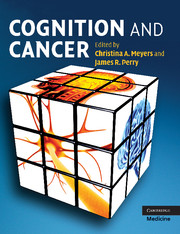Book contents
- Frontmatter
- Contents
- List of contributors
- Preface
- Section 1 Cognition and the brain: measurement, tools, and interpretation
- Section 2 Effects of cancer and cancer treatment on cognition
- 7 Biological bases of radiation injury to the brain
- 8 Cognitive dysfunction related to chemotherapy and biological response modifiers
- 9 Effect of hormones and hormonal treatment on cognition
- 10 Low-grade gliomas
- 11 High-grade gliomas
- 12 Brain metastases
- 13 Primary central nervous system lymphoma
- 14 Childhood brain tumors
- 15 Neurofibromatosis
- 16 Hematological malignancies
- 17 Paraneoplastic disorders
- 18 Symptomatic therapies and supportive care issues
- 19 Animal models and cancer-related symptoms
- Section 3 Interventions and implications for clinical trials
- Index
- Plate section
- References
8 - Cognitive dysfunction related to chemotherapy and biological response modifiers
Published online by Cambridge University Press: 13 August 2009
- Frontmatter
- Contents
- List of contributors
- Preface
- Section 1 Cognition and the brain: measurement, tools, and interpretation
- Section 2 Effects of cancer and cancer treatment on cognition
- 7 Biological bases of radiation injury to the brain
- 8 Cognitive dysfunction related to chemotherapy and biological response modifiers
- 9 Effect of hormones and hormonal treatment on cognition
- 10 Low-grade gliomas
- 11 High-grade gliomas
- 12 Brain metastases
- 13 Primary central nervous system lymphoma
- 14 Childhood brain tumors
- 15 Neurofibromatosis
- 16 Hematological malignancies
- 17 Paraneoplastic disorders
- 18 Symptomatic therapies and supportive care issues
- 19 Animal models and cancer-related symptoms
- Section 3 Interventions and implications for clinical trials
- Index
- Plate section
- References
Summary
Chemotherapy-related cognitive dysfunction
The successful management of many cancers has been achieved largely through aggressive use of therapy, which now generally combines surgery, radiation, chemotherapy, and immunotherapy. Many of these treatment strategies, including chemotherapy, are not highly specific and therefore place normal tissues and organs at risk. While the brain is afforded some protection from systemic treatments via the blood–brain barrier, it is increasingly recognized that many agents gain access to this environment via direct and/or indirect mechanisms, potentially contributing to central nervous system (CNS) toxicity. Furthermore, treatment strategies designed to disrupt or penetrate the blood–brain barrier are being explored as treatment options for a number of cancers including primary CNS lymphoma and brain metastases (Doolittle et al., 2006). Evidence will be presented supporting the existence of both chemotherapy-related cognitive dysfunction and unique neurobehavioral/psychiatric manifestations associated with biological response modifiers generally, and interferon alpha in particular.
Incidence and nature of chemotherapy-related cognitive dysfunction
Adult patients presenting with complaints of “chemobrain” or “chemofog” typically report cognitive symptoms arising soon after initiating treatment. For many patients, these symptoms persist even after therapy is complete. It is not uncommon for many patients and providers to treat these symptoms as an expected, albeit unfortunate, side-effect of treatment. Persistent symptoms are also a cause of considerable distress for individuals who are unable to return to their previous scholastic, occupational, or social activities (or are able to do so only with significant additional mental effort).
- Type
- Chapter
- Information
- Cognition and Cancer , pp. 97 - 114Publisher: Cambridge University PressPrint publication year: 2008
References
- 2
- Cited by



